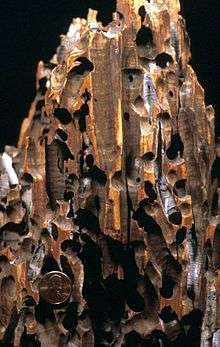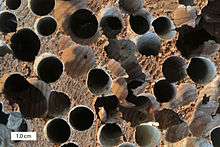Teredolites
Teredolites is an ichnogenus of trace fossil, characterized by borings in wood.
Clavate (club-shaped) structures rimming mid-Cretaceous Burmese amber from Myanmar, previously misdiagnosed as fungal sporocarps, have recently been shown to be domichnia (crypts) of martesiine bivalves (Pholadidae: Martesiinae), comparable with Teredolites clavatus Leymerie, 1842 and Gastrochaenolites lapidicus Kelly & Bromley, 1984.[1] The substrate was not wood, but amber, hence the term Amberground was coined.

Modern Teredolites in a wharf piling; the work of teredinid bivalves known as shipworms.
See also
References
- ↑ Smith, R.D.A.; Ross, A.J. (2018). "Amberground pholadid bivalve borings and inclusions in Burmese amber: implications for proximity of resin-producing forests to brackish waters, and the age of the amber". Earth and Environmental Science Transactions of the Royal Society of Edinburgh. 107 (2–3): 239–247. doi:10.1017/S1755691017000287.
External links

Teredolites; an ichnogenus formed by boring bivalves in wood.
| Wikimedia Commons has media related to Trace fossils. |
This article is issued from
Wikipedia.
The text is licensed under Creative Commons - Attribution - Sharealike.
Additional terms may apply for the media files.